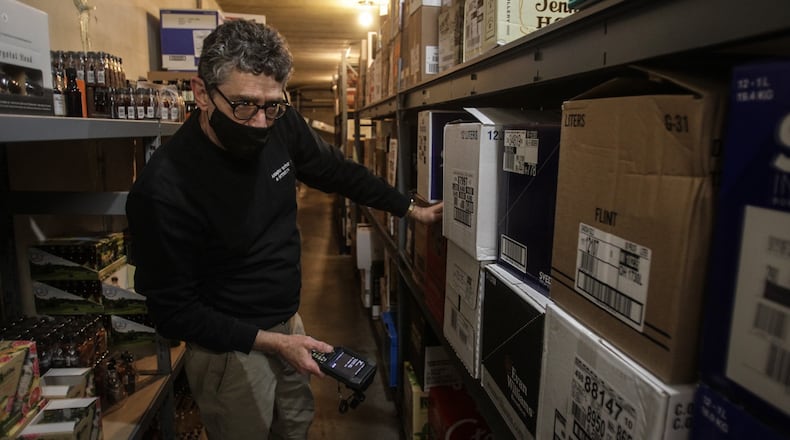Sales last year were $1.57 billion, a nearly 18.6% boost from the $1.32 billion racked up in 2019 and a nearly 27.3% boost compared to the $1.23 million earned in 2018.
Year-over-year growth is “not unusual” when it comes to liquor sales, according to Lindsey LeBerth, brand manager for the Division of Liquor Control, but the increase seen in 2020 is greater than the one that occurred between 2018 to 2019, when the amount of gallons sold increased 4% and dollar sales rose by 7.3%.
The increase in 2020, much of it influenced in March and thereafter by the coronavirus pandemic, saw the bulk of sales “significantly” shift from wholesale to retail, LeBerth said.
“This is an indication that where folks are consuming has changed from a bar or restaurant to at home,” LeBerth said. “That doesn’t necessarily mean that consumption was up, but more (that) sales were up.”
Retail gallons increased from 11,380,286.64 in 2019 to 14,175,035.38 in 2020 and retail sales increased from $978,413,645.44 in 2019 to $1,341,716,298.43 in 2020. Wholesale gallons, meanwhile, dropped from 3,864,737.99 in 2019 to 2,575,164.52 in 2020 and wholesale sales fell from $349,043,969.01 in 2019 to $232,508,759.60 in 2020.
Gallons are a better indicator of overall sales because it represents literally the amount of liquid sold, whereas dollars do not account for inflation or premiumization, the trend of choosing higher priced items, LeBerth said.
The figures provided are for high-proof spirits and do not include beer and wine sales, she said.
Chuck Gress, liquor manager of the Kettering location of Arrow Wine & Spirits, said the initial surge in sales is like nothing he’s seen in his nearly 40 years in liquor sales, 25 of them with Arrow, a Dayton-based, family-owned business that traces its roots to 1934.
“I took a picture of my shelves,” Gress said. “It looked like locusts had gone over them. I’d never seen them that empty in my life. It was like, overnight.”
It took a few weeks for Ohio stores to restock but when they did, it helped sustain steady numbers for the remainder of 2020, a sustained sales surge that made it feel “like Christmas” for the remainder of the year, he said.
“We have a season that we really sell a lot of liquor and that’s from right before Thanksgiving all the way through the end of the year but it seemed like we had that same volume the rest of the year” following the restocking effort, Gress said. “It’s been a madhouse.”
The increase in sales led Arrow Wine & Spirits to hire more employees and introduce curbside pick up, he said.
Ohio Liquor is a partnership between the Ohio Division of Liquor Control and JobsOhio Beverage System, according to the OHLQ site. JOBSOhio owns the spirituous liquor product — intoxicating liquor containing more than 21 percent alcohol by volume — in Ohio for retail and wholesale sales.
Ohio Liquor will unveil a revamped website — www.ohlq.com —sometime in the first half of 2021, LeBerth said. The project has been in the works since January 2020 and is not connected to the pandemic-fueled increase in sales.
Credit: JIM NOELKER
Credit: JIM NOELKER
“We’re really focusing on that customer experience ... adding in some great educational features and a really cool recipe section,” she said. “We’re really working on ways to educate consumers about cocktails and mocktails. We’re really wanting to be inclusive of all folks, whether they want to enjoy high-proof products or not.”
Ohio Liquor will break them down by difficultly level and by occasion-based categories. It also will roll out a “My List” feature to allow users to browse the OHLQ site and add products that they are interested in to their ‘List’.
“When the user is on the My List page, they will be able to find nearby OHLQ stores —or OHLQ stores throughout the state — that have those products in stock,” LeBerth said. “This helps the user identify which store to visit.”
Ohio has four listing periods per year where product manufacturers can submit to sell high-proof spirits in Ohio, she said. This month is seeing the rollout of 87 new products, including 27 new American whiskies and 20 new tequila products with the remainder divided between gin, rum, Scotch whiskey, Canadian whiskey, brandy and cordials.
Manufacturers were free to ship them to Ohio on Jan. 1, LeBerth said. Typically, new products are in stores within six weeks of their effective date, with some exceptions, she said.
While vodka has always been “the workhorse” of spirit sales, constituting the majority of the top bottles sold, American whiskey, especially the kind produced in Kentucky, has grown tremendously in popularity over the past five years, Gress said.
“Everybody’s mad for bourbon,” he said.
About the Author


